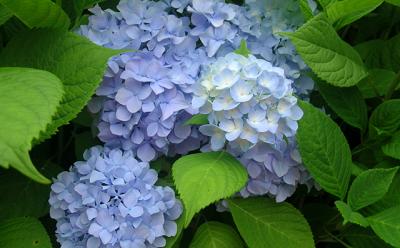Star Gardener: The Case of The Missing Hydrangeas

For the first time since they were planted in 1982, there will be no blue mophead hydrangeas flowering on my front lawn this year. And I’m afraid I will not be alone.
Travelling throughout our area, you notice dry sticks protruding above the new foliage of this icon of beach communities in the Northeast. These dead or weakened sticks are the stems of last year’s growth, off of which this year’s flowers grow. Without them, there will be few, if any, mopheads this summer.
This past winter appears to have been more difficult for hydrangeas than the winter of 2014, with its extended period of deep cold and a single cold snap in April that put paid to most of last summer’s flowers. As I recollect, earlier this year we experienced at least three cycles of very warm weather when plants broke dormancy, followed by cold spells that fried open flowers and killed soft wood.
After two bad seasons, I am seriously considering pulling the mopheads by the street, together with my favorite, the lilac hydrangea Ayesha, that didn’t make it. But then again, this is the first time in 34 years that this has happened. Odds are it’s worth waiting another year before resorting to a drastic solution.
Dennis Lemonius, of the family that owns Buckley’s garden center on the Montauk Highway and the wholesale yard in East Hampton Village, tells me he is gaining new respect for the repeat-blooming Endless Summer hydrangea. “It’s come through the past two seasons in much better condition than that old favorite Nikko Blue,” he says.
Endless Summer, with blue mopheads, was a breakthrough in hydrangeas with its ability to flower on both the previous season’s woody stems and the current season’s new growth. It has been joined by Blushing Bride, with white semi-double flowers that mature to a soft blue; Twist-n-Shout, the first re-blooming lacecap, and the newest, BloomStruck, that has very strong red-purple stems and purple mopheads.
I’ve counted at least 11 other mopheads and lacecaps that are said to be re-blooming, and the list grows longer each year. They tend to be grown by huge commercial growers like Monrovia and marketed by organizations like Proven Winners. Those who al ready are growing any of the re-blooming hydrangeas will have flowers this summer, but they will bloom later, on the new growth.
I personally have no experience growing any of them and am always skeptical of anything that is marketed as the biggest or the best. In my own garden, where I experiment with many different types of plants, I’ve learned to cut my losses, and am grateful to have the room to try something new. That’s part of what makes gardening so interesting. Why not give these new hydrangeas a try? They might actually live up to the claims on the labels.
One that caught my eye is Seaside Serenade, a Cape Cod re-blooming hydrangea, only because I was raised on the Cape and that’s where I learned to associate hydrangeas with the beach. It grows to about four feet.
Many of the other re-bloomers are compact, growing two to three feet high. There are five different cultivars in the Let’s Dance series. These would be good for the front of a planting area or in containers. Mr. Lemonius is encouraging me to try Tuff Stuff, a small, compact blue lacecap.
Of the eight different varieties of mophead/lacecap hydrangeas in my garden, the one that came through in best condition is Blue Bird, a Japanese mountain hydrangea. It is covered with small, bright, neon-blue lacecaps, generally beginning in mid to late June. An old classic that is not a re-bloomer, its flowers gradually transition to a bright ruby, giving the bush the appearance of a second flowering later in the summer. The leaves, too, turn red in autumn.
The other popular species of hydrangeas flower on new wood, so are not affected by erratic weather and late cold spells, but the flowers are white or white tinged with pink. The native oakleaf and Annabelle-type smooth hydrangeas haven’t missed a beat, and may, in fact, be opening as you read this.
If you want to make an impact, it is hard to beat a mass planting of Annabelle — which, sadly, flops. An alternative newish cultivar with stronger stems, called Incrediball, is planted just inside the gate to the Mimi Meehan Native Plant Garden, beside Clinton Academy on East Hampton Main Street, where it only gets morning sun and makes a strong statement. In my garden the bushes are in full sun, and the huge size of the mopheads is truly incredible. Is it just a little too flamboyant? Who cares?
So here are the choices. Play the odds, keeping your old bushes and letting the new growth set the scene for next year’s flowering. After all, this has been a once-in-30-years event.
Or, put your toe in the water and give one of the new repeat-blooming hydrangeas a try. Or, visit the native plant garden in another few weeks to see how you like Incrediball. You might decide to give it a go.
